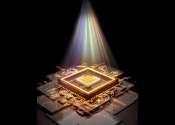How many passwords can you remember? Get ready to remember more
Got too many passwords to remember? Just wait. It's going to get a lot worse.
Dec 16, 2018
4
47
Security

Got too many passwords to remember? Just wait. It's going to get a lot worse.
Dec 16, 2018
4
47
Security

WhatsApp, text or email—which is the most secure option when your conversation really has to be locked down?
Oct 14, 2019
1
4
Engineering

In a groundbreaking new study, researchers at the University of Minnesota Twin Cities used a customized printer to fully 3D print a flexible organic light-emitting diode (OLED) display. The discovery could result in low-cost ...
Jan 8, 2022
0
1553
Hardware

The bad news: A security research firm has found that Intel chipsets used in computers over the past five years have a major flaw that allows hackers to bypass encryption codes and quietly install malware such as keyloggers.
Computer Sciences

In recent years, numerous computer scientists and artists worldwide have worked on projects that merge digital art and computer science. For instance, some introduced computational models that can create original artworks, ...
Computer Sciences

Around a century ago when film stocks and photographs were first coming to light, they faced a number of challenges in capturing the essence of an image. In addition to the black and white limitation, photography and film ...
Engineering

We're used to measuring our digital devices by how fast they are, how clear the sound is, how crisp the display is, how large the storage capacity is.
Hardware

Researchers from Tsinghua University, China, have developed an all-analog photoelectronic chip that combines optical and electronic computing to achieve ultrafast and highly energy-efficient computer vision processing, surpassing ...
Hardware

In recent years, electronics engineers have been trying to develop new brain-inspired hardware that can run artificial intelligence (AI) models more efficiently. While most existing hardware is specialized in either sensing, ...
Internet

Countless companies around the world see the wildly popular video-conferencing tool Zoom as a savior during this era of quarantine and work-at-home routines. Zoom estimates it has more than 300 million meeting participants ...
A digital system is a data technology that uses discrete (discontinuous) values. By contrast, non-digital (or analog) systems use a continuous range of values to represent information. Although digital representations are discrete, the information represented can be either discrete, such as numbers, letters or icons, or continuous, such as sounds, images, and other measurements of continuous systems.
The word digital comes from the same source as the word digit and digitus (the Latin word for finger), as fingers are used for discrete counting. It is most commonly used in computing and electronics, especially where real-world information is converted to binary numeric form as in digital audio and digital photography.
This text uses material from Wikipedia, licensed under CC BY-SA